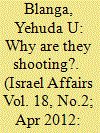| Srl | Item |
| 1 |
ID:
088139


|
|
|
|
|
| Publication |
2009.
|
| Summary/Abstract |
IN THE MIDDLE EAST Russia concentrates, to a great extent, its political-diplomatic efforts at creating a sustainable and reliable security system in the zone (or sub-region) of the Persian Gulf occupied by eight states: Bahrain, Iraq, Iran, Qatar, Kuwait, United Arab Emirates (UAR), Oman and Saudi Arabia. Its mineral wealth - about two-thirds of the world's explored reserves of oil and about one-third of the world's gas reserves - has made it critically important for global economic and energy security.
The current situation that has taken several decades to reach the present stage is best described as permanent instability worsened by repeated crises. The best illustration of many faults of the unipolar world, it was shaped by a series of bloody armed conflicts: the Iran-Iraq war of 1980-1988; the Kuwait crisis and the Desert Storm of 1990-1991 and the 2003 war in Iraq.
Since the early 1980s, the United States has been positioning itself as the main source of stability in the Gulf zone, a sphere of its vital interests.
|
|
|
|
|
|
|
|
|
|
|
|
|
|
|
|
| 2 |
ID:
111896


|
|
|
|
|
| Publication |
2012.
|
| Summary/Abstract |
This article examines the episode of an almost-forgotten war in the history of the Middle East conflict - the War of Attrition. While everyone agrees that the War of Attrition ended on August 7, 1970, there is controversy over when the war broke out. Some consider it to have begun in the summer of 1968 and others believe that it began with the bloody events that occurred immediately after the Six Day War. The IDF considers March 8, 1969 to be the day the war broke out because from that day on there was continuous fighting with the Egyptian side of the Suez Canal.
To show the American and Israeli failure, in the first four months of hostilities along the Suez Canal, to understand that the area was facing renewed conflict and another round of war. A direct consequence of that failure was the inability of both sides to adopt a suitable policy towards the emerging crisis. The article examines the beginning of the War of Attrition in the diplomatic arena, the Egyptian aims and objectives, and the American reaction. Other than presenting the facts, this article examines what the United States thought of the Egyptian moves, if and how much the United States was influenced by those moves, and Egyptian President Gamal Abdel Nasser's reaction to the steps taken by the Americans. Since the main focus is on the American foreign policy, most of the sources used for this article are American. In order to complete the picture, it is also important to examine the Israeli point of view and the last part will focus on that.
|
|
|
|
|
|
|
|
|
|
|
|
|
|
|
|